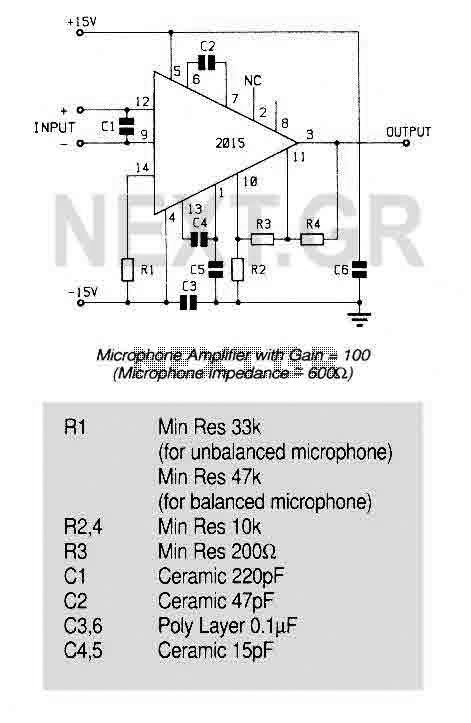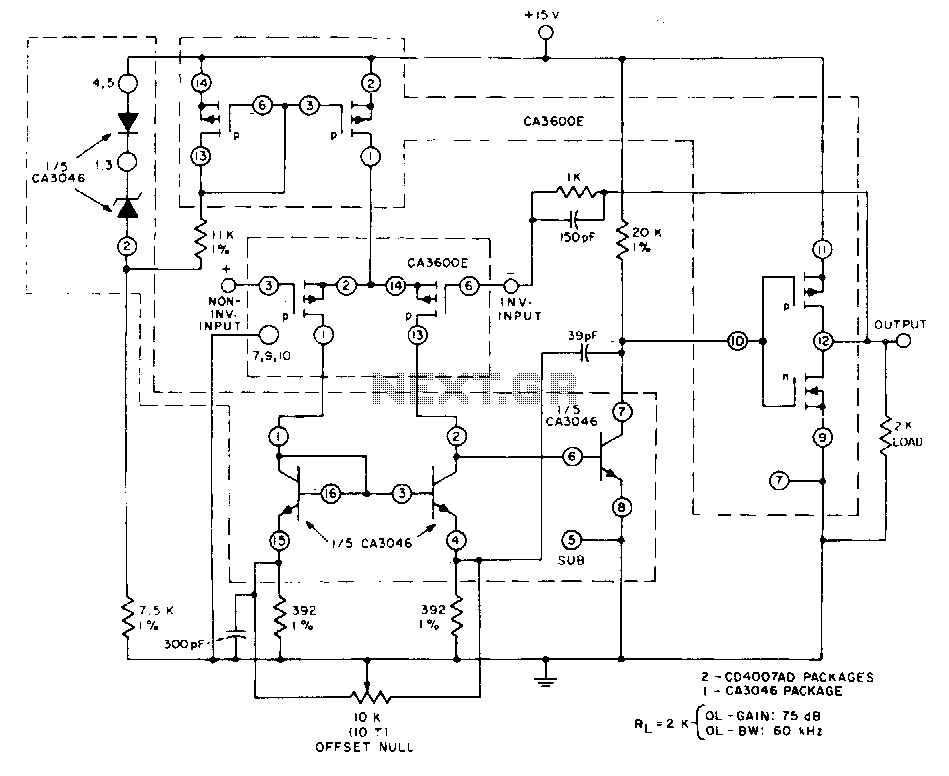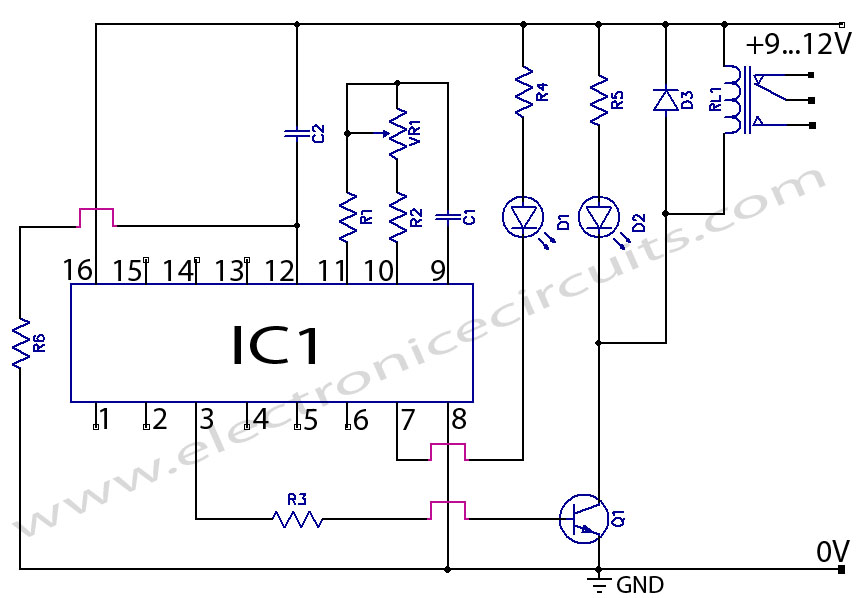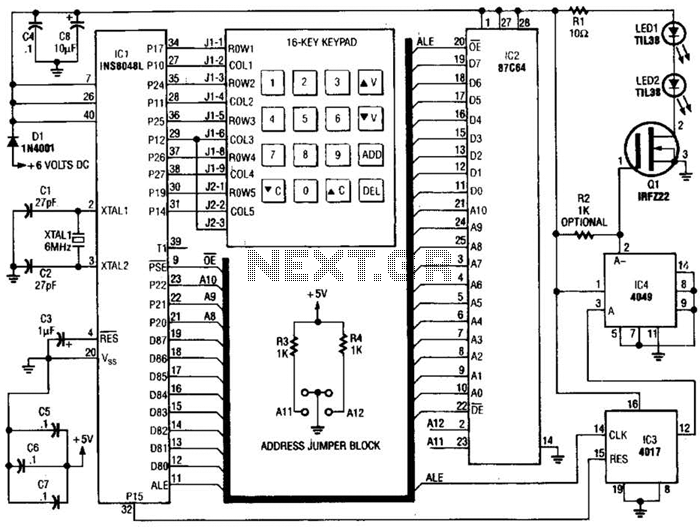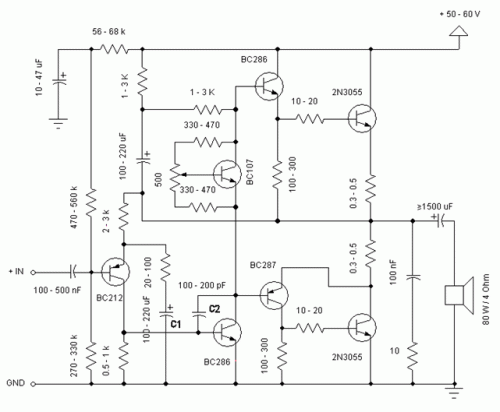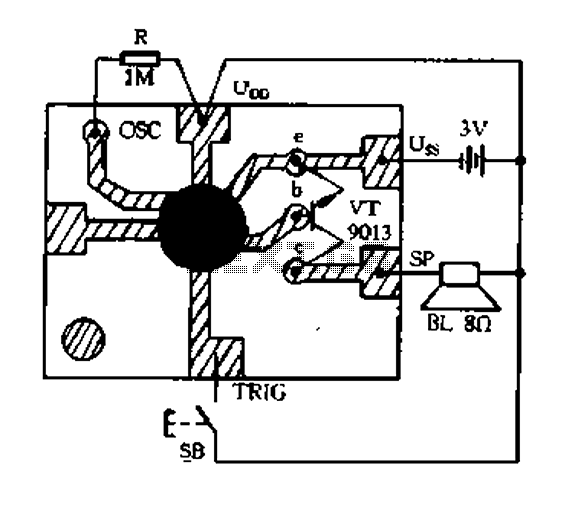
Broadcast Band Rf Amplifier Circuit
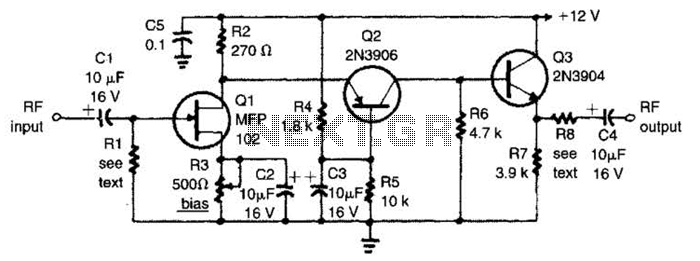
The circuit features a frequency response that spans from 100 Hz to 3 MHz, with a gain of approximately 30 dB. Field-effect transistor Q1 is arranged in a common-source self-biased configuration, and an optional resistor R1 is available to adjust the input impedance to the desired level, typically set at 50 ohms. The signal is then directly coupled to Q2, which operates in a common-base configuration, effectively isolating the input and output stages while ensuring exceptional stability for the amplifier. Finally, Q3 acts as an emitter-follower, providing a low output impedance of about 50 ohms. For applications requiring higher output impedance, resistor R8 can be added; its impedance will be influenced by the formula: Rs ~ ^0lJT - 50. Alternatively, the output capacitor C4 can be directly connected to the emitter of Q3.
The described circuit is a versatile amplifier design, suitable for a range of applications where signal integrity and stability are critical. The frequency response of 100 Hz to 3 MHz indicates its capability to handle both audio and high-frequency signals, making it ideal for communications and signal processing tasks. The gain of 30 dB is indicative of a moderate amplification level, suitable for boosting weak signals without introducing significant distortion.
The common-source configuration of Q1 allows for high voltage gain and is particularly effective in amplifying low-level signals. The optional resistor R1 provides flexibility in setting the input impedance, which is crucial for matching the circuit to various signal sources. A typical value of 50 ohms is often used to match standard RF components, ensuring maximum power transfer and minimizing signal reflections.
The common-base configuration of Q2 serves a dual purpose: it not only isolates the input from the output but also contributes to the overall stability of the amplifier. This configuration is known for its low input impedance and high output impedance, which is beneficial in applications where signal isolation is necessary.
Q3, as an emitter-follower, is designed to deliver a low output impedance, which is advantageous for driving loads that require current without significant voltage drop. The output impedance of approximately 50 ohms allows for effective interfacing with subsequent stages or external loads.
In scenarios where higher output impedance is desirable, the incorporation of resistor R8 offers a straightforward solution. The relationship defined by the formula Rs ~ ^0lJT - 50 allows for precise control over the output characteristics, enabling the circuit to adapt to varying load requirements.
The option to connect output capacitor C4 directly to the emitter of Q3 provides an alternative output configuration, which may be useful in specific applications where coupling capacitors are required to block DC components while allowing AC signals to pass through.
Overall, this amplifier design combines flexibility, stability, and adaptability, making it suitable for a diverse range of electronic applications. The circuit has a frequency response that ranges from 100 Hz to 3 MHz; the gain is about 30 dB. Field-effect transistor Ql is configured in the common-source self-biased mode; optional resistor R1 allows you to set the input impedance to any desired value. Commonly, it will be 50 . The signal is then direct-coupled to Q2, a common-base circuit that isolates the input and output stages and provides the amplifier`s exceptional stability.
Last, Q3 functions as an emitter-follower, to provide low output impedance (about 50 ). If you need higher output impedance, include resistor R8. It will affect impedance according to this formula: Rs ~ ^0lJT - 50. Otherwise, connect output capacitor C4 directly to the emitter of Q3. 🔗 External reference
The described circuit is a versatile amplifier design, suitable for a range of applications where signal integrity and stability are critical. The frequency response of 100 Hz to 3 MHz indicates its capability to handle both audio and high-frequency signals, making it ideal for communications and signal processing tasks. The gain of 30 dB is indicative of a moderate amplification level, suitable for boosting weak signals without introducing significant distortion.
The common-source configuration of Q1 allows for high voltage gain and is particularly effective in amplifying low-level signals. The optional resistor R1 provides flexibility in setting the input impedance, which is crucial for matching the circuit to various signal sources. A typical value of 50 ohms is often used to match standard RF components, ensuring maximum power transfer and minimizing signal reflections.
The common-base configuration of Q2 serves a dual purpose: it not only isolates the input from the output but also contributes to the overall stability of the amplifier. This configuration is known for its low input impedance and high output impedance, which is beneficial in applications where signal isolation is necessary.
Q3, as an emitter-follower, is designed to deliver a low output impedance, which is advantageous for driving loads that require current without significant voltage drop. The output impedance of approximately 50 ohms allows for effective interfacing with subsequent stages or external loads.
In scenarios where higher output impedance is desirable, the incorporation of resistor R8 offers a straightforward solution. The relationship defined by the formula Rs ~ ^0lJT - 50 allows for precise control over the output characteristics, enabling the circuit to adapt to varying load requirements.
The option to connect output capacitor C4 directly to the emitter of Q3 provides an alternative output configuration, which may be useful in specific applications where coupling capacitors are required to block DC components while allowing AC signals to pass through.
Overall, this amplifier design combines flexibility, stability, and adaptability, making it suitable for a diverse range of electronic applications. The circuit has a frequency response that ranges from 100 Hz to 3 MHz; the gain is about 30 dB. Field-effect transistor Ql is configured in the common-source self-biased mode; optional resistor R1 allows you to set the input impedance to any desired value. Commonly, it will be 50 . The signal is then direct-coupled to Q2, a common-base circuit that isolates the input and output stages and provides the amplifier`s exceptional stability.
Last, Q3 functions as an emitter-follower, to provide low output impedance (about 50 ). If you need higher output impedance, include resistor R8. It will affect impedance according to this formula: Rs ~ ^0lJT - 50. Otherwise, connect output capacitor C4 directly to the emitter of Q3. 🔗 External reference
Warning: include(partials/cookie-banner.php): Failed to open stream: Permission denied in /var/www/html/nextgr/view-circuit.php on line 713
Warning: include(): Failed opening 'partials/cookie-banner.php' for inclusion (include_path='.:/usr/share/php') in /var/www/html/nextgr/view-circuit.php on line 713
